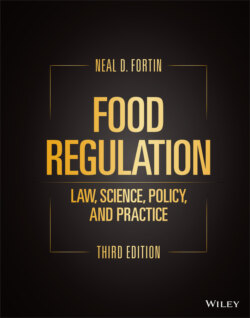Читать книгу Food Regulation - Neal D. Fortin - Страница 98
3.2 LEGAL AUTHORITIES
ОглавлениеFDA’s authority to compel the labeling of food products primarily derives from the Food, Drug, and Cosmetic Act (FD&C Act). Many of the statutory labeling requirements come from section 403 of the FD&C Act, which lists circumstances when a food will be considered “misbranded.” The definition of “misbranded” contains the major misbranding requirements:
1 Mandatory labeling of the name of the food, ingredient statement, net quantity, and the name and address of the manufacturer or distributor.
2 Mandatory standards of identity.
3 Labeling of imitation foods.
4 Nutrition information for special dietary foods.
5 Prohibition of any false or misleading claims.
The Fair Packaging and Labeling Act (FPLA), 15 U.S.C. 1451 et seq., was enacted in 1966 to prevent unfair and deceptive trade practices, and to provide consumers with accurate information regarding the quantity and value of products. The FPLA is administered by the FDA for labels on foods, drugs, and cosmetics, while the Federal Trade Commission (FTC) administers the FPLA for most other consumer commodities.
FDA’s labeling regulations are located in 21 C.F.R. 101 and cover both the requirements of the FD&C Act and the FPLA.
Labeling of meat, poultry, and egg products is regulated under separate laws by the United States Department of Agriculture (USDA). The major principles and many of the specifics are the same in both sets of requirements. This chapter provides an overview of the differences.
